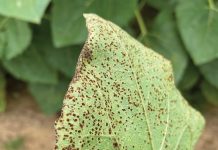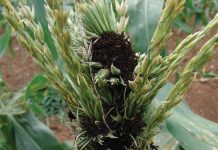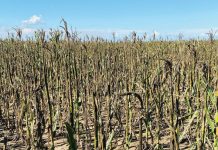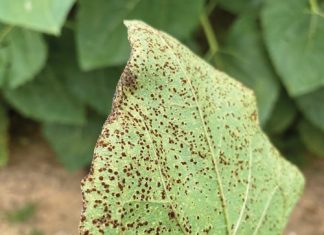

Keabetswe Baloyi,
ARC-Grain Crops, Potchefstroom
Diplodia ear rot, caused by the fungus Stenocarpella maydis, is a global concern. This disease typically emerges in seasons marked by early drought periods followed by prolonged and excessive rainfall during the maize plant’s maturation stage. The fungus produces specific mycotoxins, which have been shown to affect animals in a variety of ways recorded across various studies.
Many of these studies were initially conducted in South Africa where field symptoms of diplodiosis were first reported. Diplodiosis is a nervous disorder in cattle and sheep resulting from the ingestion of mouldy ears that are infected by S. maydis. The recent ability to isolate and characterise diplodiatoxin now enables researchers to study the toxin itself and not only the fungus that produces it. This article will provide an overview of recent research advances at ARC-Grain Crops on Diplodia as well as on the occurrence of Diplodia ear rot and diplodiatoxin in maize grain production areas of South Africa.
Stenocarpella maydis ear rot
Early-season drought followed by late-season rain can trigger epidemics of Diplodia ear rot, particularly in areas where high inoculum sources are present on stubble-covered soil. This fungus can develop spore-producing structures that become dormant on maize stubble during winter and reactivate in spring.
The spores from these spore-producing structures infect plants throughout the growing season. During periods of rainfall or high humidity, the structures release spores into the air. The spores land on maize plants and infect the base of the ear/leaf junction, where they then spread upwards into the ear. The entire ear can become overgrown with white mycelial growth (Photo 1).
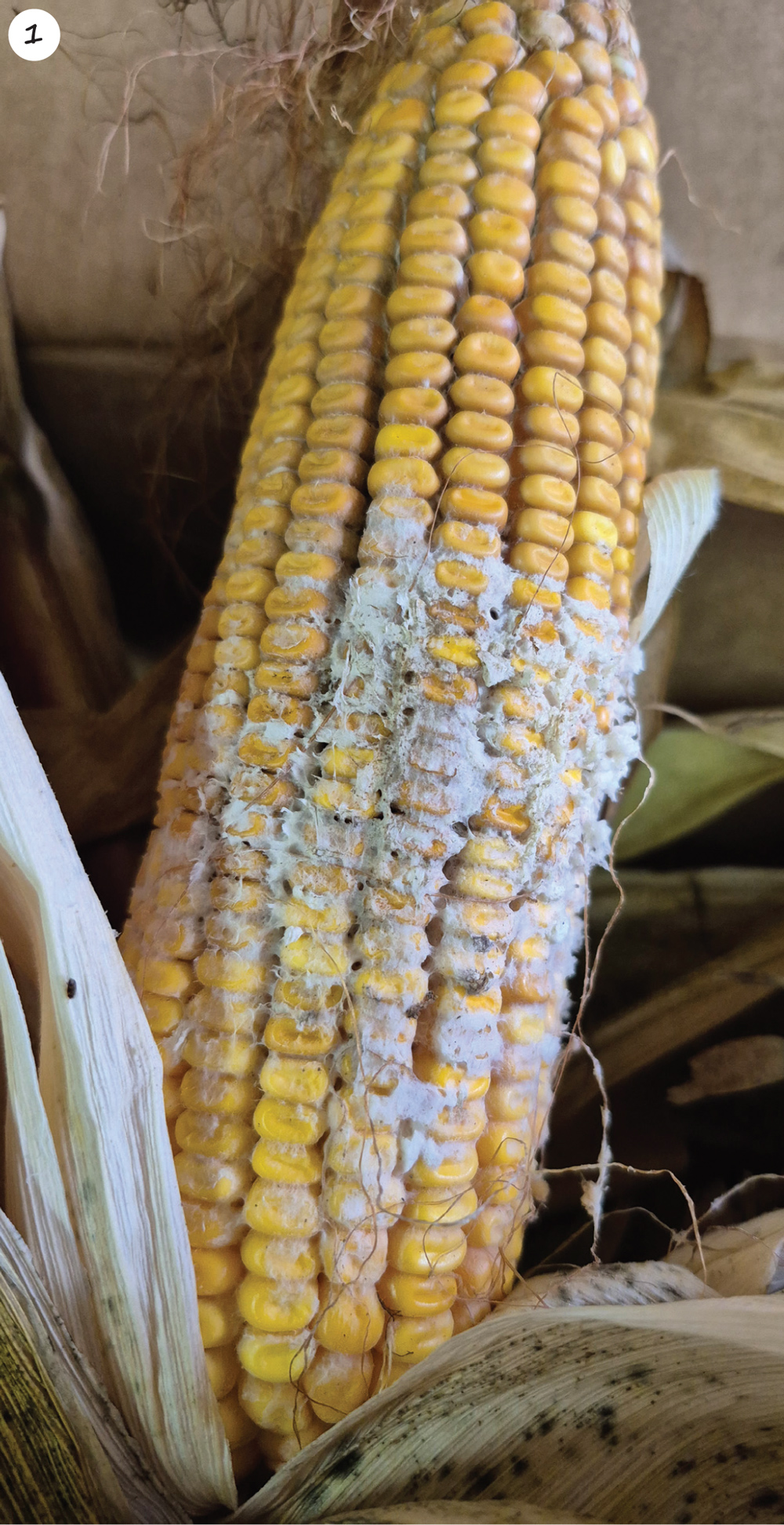
A cross-section of an infected ear reveals black spore-producing bodies at the kernel bases (Photo 2). Late-season infections may occur when kernel moisture is low, but these symptoms are less obvious. Infections that show little or no symptoms are locally
referred to as skelm (sly) Diplodia.
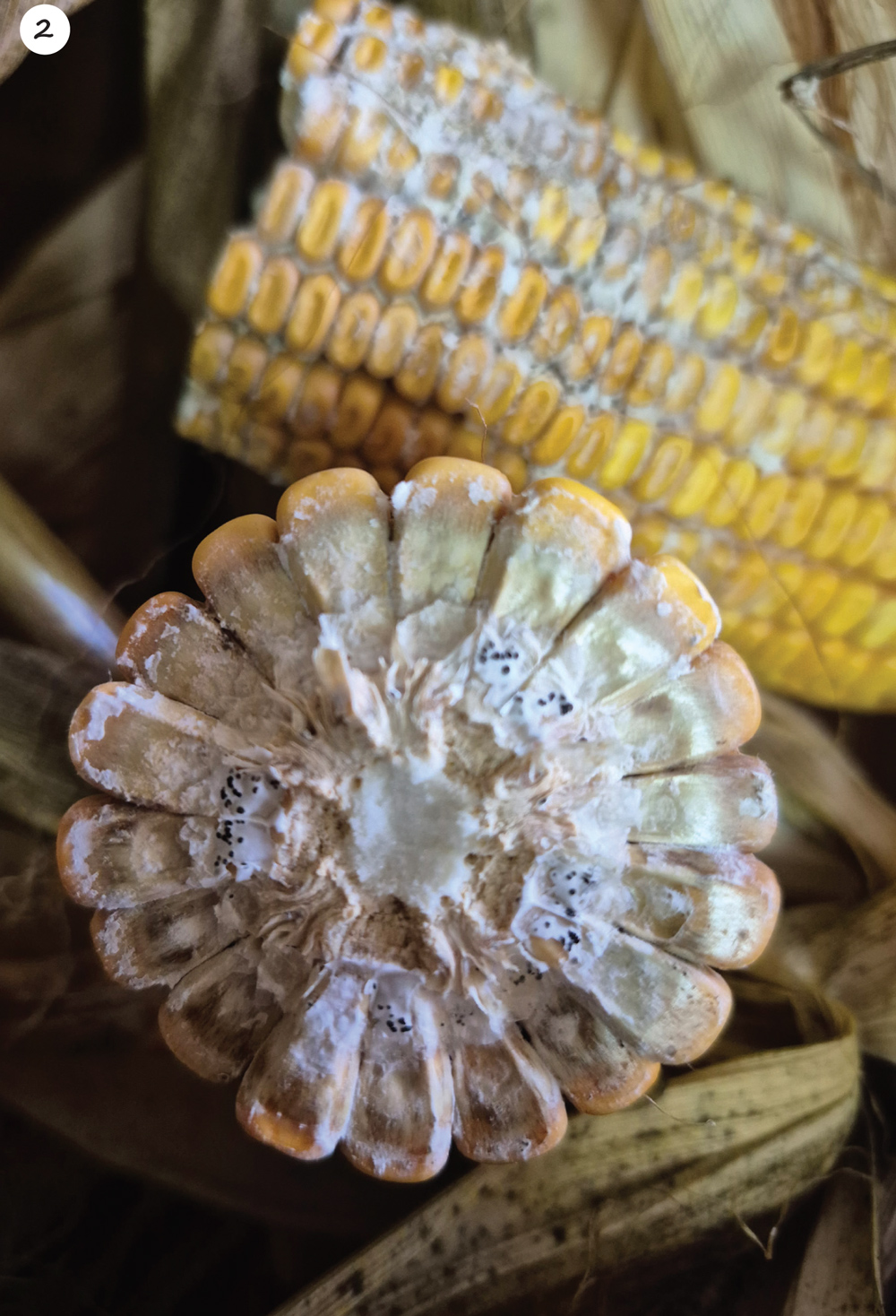
Diplodiosis and associated mycotoxins
The first record of diplodiosis in South Africa was reported by Van der Bijl in 1914 in the Mooi River region of KwaZulu-Natal. He documented an outbreak of ‘sickness’ in cattle that was characterised by paralysis that followed after grazing on harvested maize fields. Over the last three decades, various reports of diplodiosis in livestock have been received from veterinarians and producers in South Africa. However, these outbreaks have not conclusively been linked to Diplodia-contaminated residues.
Diplodiosis is a nervous-system disorder in cattle and sheep, resulting from the ingestion of ears infected by S. maydis. Cases of diplodiosis typically occur six to fourteen days after animals started to graze on fields with infected maize ears. The disease is characterised by a reluctance to move, a wide-based stance, incoordination, tremors, paralysis, and death. It also causes abnormal foetal development and death. Field outbreaks of diplodiosis in Southern Africa are favoured by late, heavy rains and typically occur during the late winter months (July to September). The practice where producers use harvested maize fields for winter grazing majorly contributes to mycotoxicosis outbreaks.
In addition to diplodiatoxin, new metabolites such as dipmatol, diplonine, and chaetoglobosins K and L have recently been isolated from Diplodia-infected crops. To date, none of these pure metabolites have been administered to ruminants to reproduce the disease. Laboratory analytical test methods to quantify and establish the presence and distribution of these toxins in infected maize commodities are also lacking. To bridge this gap, research funded by the Maize Trust and led by the ARC-Grain Crops, along with the University of Pretoria (Departments of Chemistry and Veterinary Science), the Tshwane University of Technology (Department of Biotechnology and Food Technology) and the South African Grain Laboratories (SAGL) has managed to synthesise diplodiatoxin and develop a quantification method. Continued funding from the Maize Trust and the Department of Agriculture is allowing researchers to determine the natural levels of Diplodia infections and diplodiatoxin in maize grain across maize-producing areas of South Africa. Fungal isolates from these studies will be used to quantify toxicity in day-old ducklings.
What are the benefits from the research?
Enhanced safety: The development of an analytical test method ensures that maize products and animal feed are free from harmful mycotoxins that have a negative influence on human and animal health.
Disease management: Routine testing for diplodiatoxin allows researchers to confirm or disprove diplodiosis cases, which enables timely and effective intervention methods to manage and prevent outbreaks.
Agricultural advantage: South African maize and livestock producers gain a distinct advantage with access to advanced technology that ensures the safety and quality of their products. For the producer this technology can, potentially, improve marketability and consumer trust.
Regulatory support: Due to scanty information, legislation is not currently in place. The research results will play a major role when legislation is discussed in future.
Research opportunities: The availability of these technologies opens up new avenues for research that benefit both the South African and international research communities. For example, it enables the study of Diplodia mycotoxins and their effects so that it can lead to practical solutions for managing and mitigating their impact.
Overall, this research provides comprehensive benefits that enhance food safety, support agricultural practices, and contribute to scientific advancements.
Distribution and spread
During the 2023/2024 harvest season, 300 samples were collected from both commercial and smallholder farms across the Free State, North West, Eastern Cape, Mpumalanga and Limpopo provinces (Figure 1). Each maize grain sample was surface-sterilised and plated out to assess the severity of Diplodia infections. Sub-samples were sent to the SAGL for liquid chromatography–mass spectrometry (LC/MS) analysis to quantify diplodiatoxin levels. The mean severity of Diplodia infections was highest in the Eastern Cape and lowest in Mpumalanga (Figure 2).
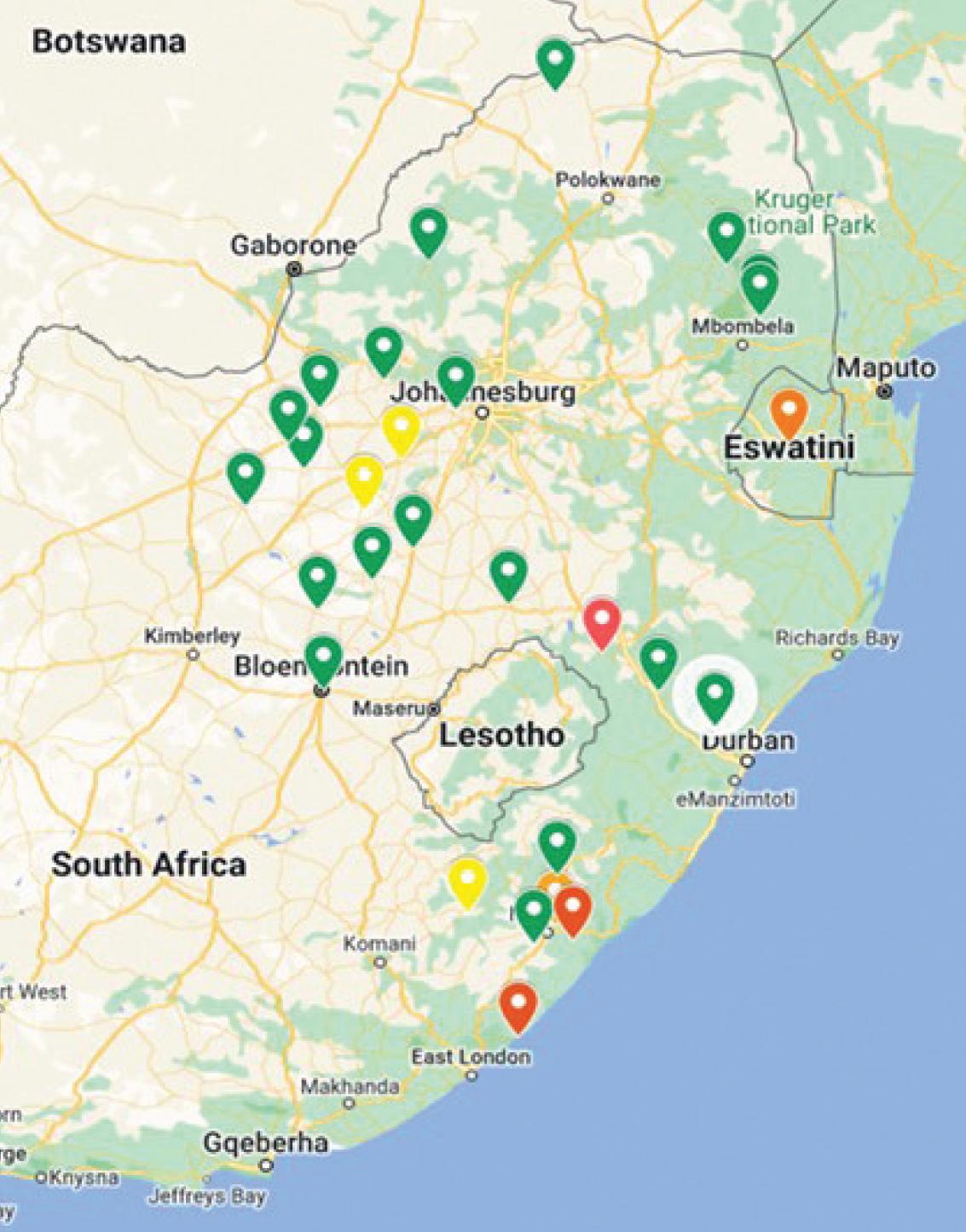
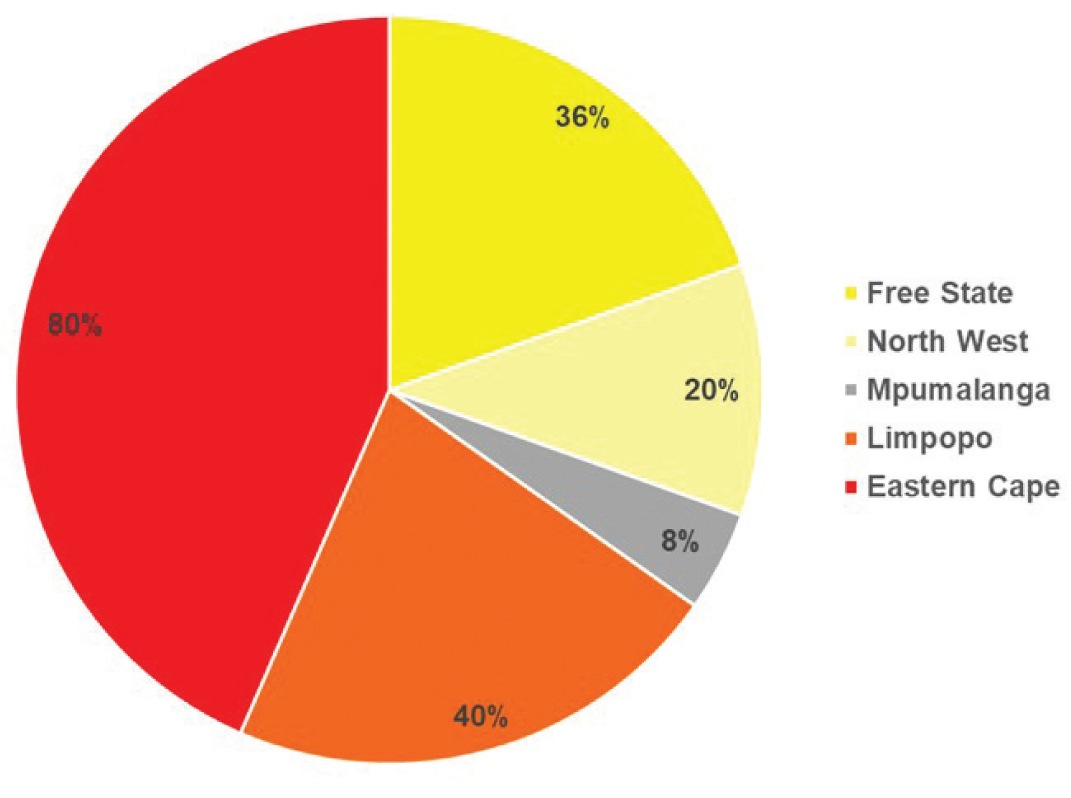
Control measures
Stubble reduction/retention
Control of Diplodia ear rot involves the reduction of surface maize stubble through grazing, burning, baling, or ploughing. The fungus flourishes on maize stubble but survives poorly in soil. Therefore, any practice that reduces infected surface stubble will lower initial inoculum concentrations in the field. However, the removal of stubble for a single season followed up by a return to stubble retention practices will only reduce Diplodia ear rot for the specific season where stubble was removed. In the presence of stubble that following season, the risk of Diplodia ear rot will return to its original level if weather conditions are favourable for the development of this fungus.
Stress reduction
Avoid high plant populations on marginal soils and in areas prone to drought, leaf or alternate stalk rot disease conditions. Ensure adequate, balanced plant nutrition relative to the yield potential of the field or area to be planted. Unnecessary stressors on the crop may increase the potential for Diplodia stalk rot that can, potentially, lead to an epidemic under favourable conditions. In the long run, this may indirectly increase inoculum levels on the field.
Crop rotation
Crop rotation can reduce Diplodia ear rot inoculum levels in two ways. Firstly, a non-host crop will not allow the fungus to survive in the absence of maize. Secondly, a longer period (a season or two) between maize crops allows for the natural breakdown of maize stubble and thus reduces the survival rate of the fungus. Leguminous crops such as soybean, dry bean, groundnut and cowpea are excellent crops to include in a maize-based crop rotation system. Other effective rotation crops include wheat and oats. Sunflower, on the other hand, do not significantly reduce Diplodia ear rot under experimental conditions for reasons that cannot yet be explained.
Early harvesting
Early harvesting reduces Diplodia ear rot and limits the time available for the fungus to grow on the ear. Late or winter rains cause the ears to remain wet, in turn increasing the probability of fungal growth. In some cases, it may be beneficial to harvest early at higher moisture levels and then dry the grains artificially. This practice is indeed applied in the United States, which likely explains why Diplodia ear rot is not a major problem there.
 Hybrid resistance
Hybrid resistance
Selecting resistant cultivars is crucial for controlling Diplodia ear and stalk rots. Generally, under similar conditions, a resistant hybrid will have less Diplodia ear rot than susceptible hybrids. This effect results from the interaction between the available inoculum, the host and prevailing weather conditions. Many maize hybrids react consistently across all localities but a number of them do not.
For more information regarding Diplodia ear rot, please contact Dr Belinda Janse van Rensburg at 018 299 6357.



